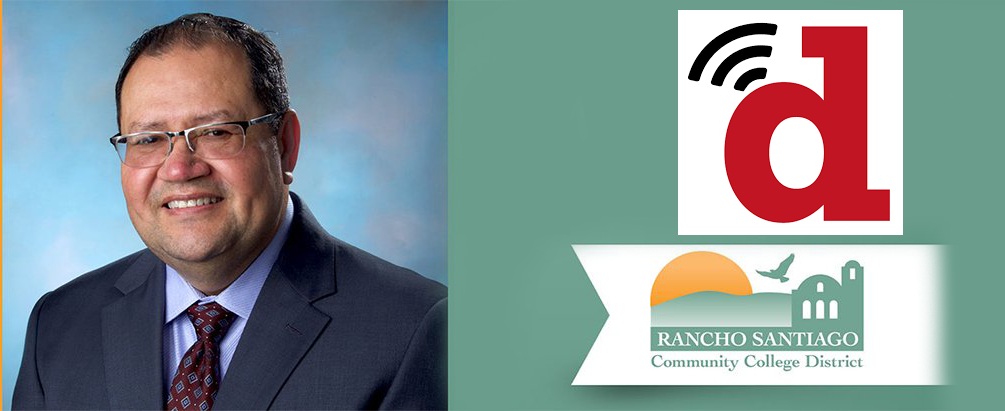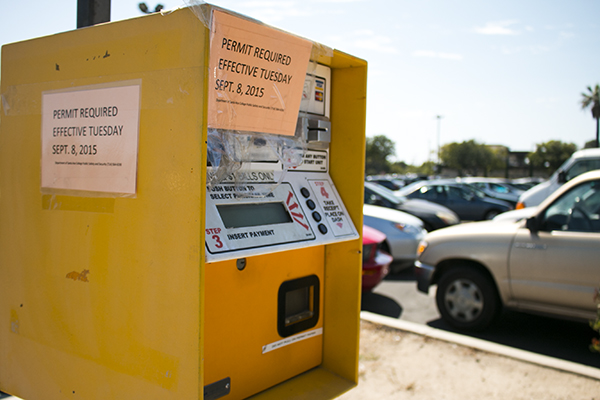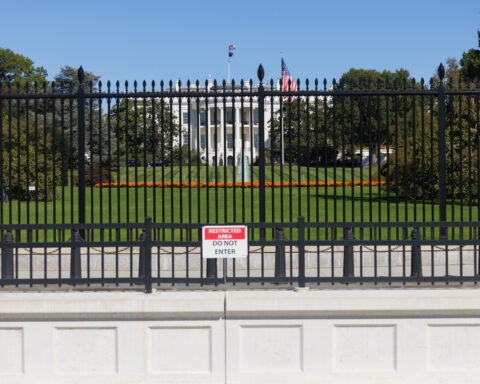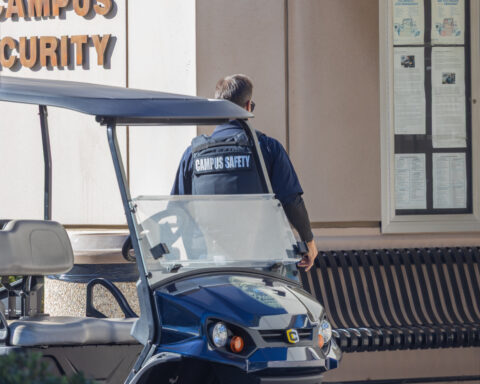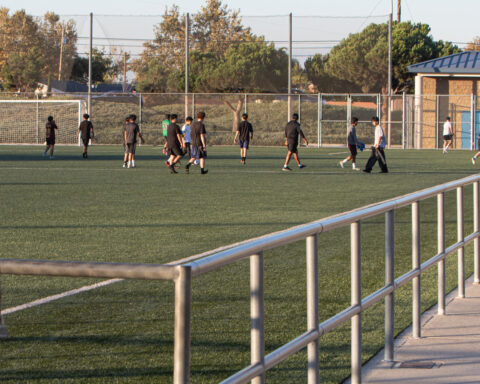Do you want to give any updates to the audience about what’s been going on the last week?
Sure. So, we’re beginning to have discussions about the fall semester and as all of you know, we made a decision to also offer the summer session through remote instruction and online instruction. And we’re having discussions also now about the Fall. The governor, Governor Newsome, has identified a six point plan of how he wants to open up the state. And within that plan, which I believe is point five, he provides us some guidance that relates to how schools, how colleges will look like. He does talk about social distancing, that social distancing should be followed in the classrooms. So if we’re going to have a class, we will need to separate students by six feet or more. He also talks about, if we are going to have a class open on campus that students should probably, not probably, but they need to wear face masks. They may need to wear gloves. Obviously, we’ll need to issue that to students also. We’ll have them available, but if the students have a facemask, they can bring their own. So that’s what so far he has identified in his guideline. The issue though is that he still has not stated when he intends to open up the state, what day that will be. And, well given what happened today, it’s not going to happen anytime soon. Nevertheless, as you know, when we plan a semester, like the fall semester we try to do that three months ahead of time. Wouldn’t try to do that overnight. And we do that so that we can also inform students about the schedules, of when they can enroll in classes. I think to me the big issue is: should we offer the entire semester, the fall semester, again online? And through distance education. And as you know, are the universities– you have heard about Cal State Fullerton? So Cal State Fullerton has decided they’re just going to go online in the fall. I believe also UC Irvine has made that decision. I also have heard that Cal State Long Beach has made that decision. And I think the reason many of them are also moving in that direction is because, if we’re going to offer a class on the campus and it needs to be distance of six feet or more, what will be the class size limit? So you have classes that have 40 students, or 50 students, but with social distancing that’s going to have to be cut almost in half. And is it possible to offer still that class? You’re going to need like two classrooms or so to offer that one class. So the feasibility of it is not easy and the coordination of it, it’s not easy. So we are looking into that. The governor’s sixth point in that plan talks about the fact that if there’s a spike in cases again, if there’s a surge cases, that he will once again implement his stay at home executive order and he’ll tell everybody, ‘Forget coming to the campuses. Everything needs to go online.’ And so it’s a monumental task to take a large portion of the curriculum and to convert it overnight to online again and I think all of you went through that. So we need to be strategic about this, you know, because it could happen. There’s still no vaccine, there’s still no cure. People can still get infected. If we are going to offer any classes face to face on the campuses, to me, it will be a small number of classes, probably a good number of them will be the CTE courses or courses that require labs where students just have to know that they don’t know yet how to offer that class online. You know, I’m talking about from automotive tech to welding and those courses are a portion of them that you can do theoretically, but also there’s a portion of that class that has to be done face to face. So again, if we come back, when we come back in the fall, what we’re going to offer face to face will be small. Meaning that the majority of the classes, at least 90%, could still be online. So again, we’re talking about it. We want to make some key decisions as quickly as possible so that we can inform students about the fall semester and you’ll know what we’re going to be offering still remotely and online and what classes we may still have face to face. Keep an eye out as soon as some of those key decisions can be made. We are working closely with faculty leaders and student leaders so we can make those key decisions and let everybody know what will happen in the fall semester.
Have there been any updates concerning the refunds on parking and health and wellness fees?
So let’s talk about parking fees first for the spring semester. We are planning to return a portion of the parking fees to students. It will be prorated, meaning that, as you know we closed the spring semester beginning March 13. We were open for a few weeks, so we’ll prorate it and that portion that’s due back to students, we want to be able to get it to them within two weeks at the latest. I mean, parking for students, I think if you’re full time, I think you pay $30. You’re not going to get the full $30 but you’ll get a good portion of that back.
We do want to give those parking fees back to students for the spring. For the summer session, because it’s all going to be online, remote instruction, we’re not going to charge students at all for parking fees. Wanted to let you know that. And then going back again to the fall semester, if we make a decision where 90% of the classes will still be online, we’re probably again not going to charge students to park on the campuses. I wanted to share that with you.
In regards to the federal stimulus and the CARES Act, we finally received notification yesterday from the Department of Education that we can begin to draw down to dollars and begin to issue grants to students. The colleges are working to make that happen. I’m hoping that they can make that happen quickly and hopefully in the next two weeks, we can get the grants going to students. Other information that we learned is that obviously that you can’t use the CARES Act dollars, the federal stimulus dollars, to give grants to undocumented students and DACA students. So I’ve asked both campuses to identify dollars from their foundations so that we can give dollars also to undocumented students and DACA students. We want to be able to give the undocumented students and DACA students the same amount of money that we’re giving everybody else.
We’re not going to treat undocumented students, DACA students, as second-class citizens. We’re not going to do that. We’re going to give them the same amount. We want to give it to them at the same time we’re giving the other checks out. Because they are in need for those resources like everybody else. Wanted to also share that with you. I’m excited about that. Obviously, every little bit helps and we want to make sure that we can get those dollars out to all the students
Since you mentioned the CARES Act federal stimulus funds and the refunds, how are our students going to get refunded? Who can the student’s contact, or is it going to be mailed directly to them?
Yeah, so we’re probably going to go ahead and just mail checks to students for parking fees. In regards to the grants coming from the federal stimulus, we’re probably going to do something similar to that. I’ve asked the campuses to also connect with students to see if they have a bank account and we can even directly deposit it there. I’m sure you’re hearing, Leslie, and I’m hearing about checks getting stolen. So, I am concerned about that. But I don’t know if all the students have bank accounts, and if they don’t have don’t have a bank account, then we’re just gonna have to just give them a check and mail a check to them. So again, both colleges are trying to resolve that on their campuses and that’s why it’s going to take a little bit of time. We’re not going to be able to do this overnight, because we want to make sure that that check goes to the student and it doesn’t get lost along the way. It doesn’t get stolen along the way. But they get those checks and unfortunately, we can’t do things on a campus and we can’t have them come to the campus and line up. But we may have to do that for those students that don’t have a bank account or maybe we have an old address from them and they moved and live somewhere else. So we may just ask them, they’ll come to the campus and pick up the check.
Sorry to interrupt but correct me if I’m wrong. On the Canvas [WebAdvisor] website for students, they can change their address and their personal information, correct?
Yeah, they could do that. Who’s going to lead this effort from the campuses will be the financial aid offices, so I don’t know if the financial aid offices know that they can draw down the address if a student makes a change to Canvas [WebAdvisor].
But again, you know, we’ll make sure that they get the right address. I think what students need to do is that if they have moved and they are no longer live where they used to live two weeks ago, then they should let us know somehow. Maybe Canvas [WebAdvisor] may be the way to go, but I can get back to you as to how they can let the campuses know.
But again, even if we have to have students come to the campus to pick up the check, and if that’s what needs to happen, that’s what needs to happen.
Our goal is to make sure they get the check. And our goal is to make sure that that check does not get lost along the way and it doesn’t get stolen. That’s what we’re trying to resolve.
I’ve been talking to some students for the past week, and it seems that a lot of students are confused about whether the office is open. Can you clarify what services are open and who still available and how can we reach them?
All services are open, but let me provide some details of what that means. Well, as you know, the new normal is no longer the normal, so what open means today is that you can access your information online. I know some offices on the campuses [have] their staff physically there. I don’t know what days they are there, they’re not there every day. I can get that information to you quickly; I can get it so that you can find out. But the point here is that we’re trying to avoid having students come to the campus because the whole purpose of the executive order is they don’t want anybody on the campus. But I know that not all business can be taken care of online. Sometimes you may have to come to the campus. So we want to be able to be accessible to students in that manner as well. But as you know, I’m sure there’s other students who just don’t want to come to the campus. They don’t want to be infected and I get that. So I can find out for you the various offices student services or programs, from financial aid, admissions counseling, I can find out for you which days and hours of the day they are open so that in case students need to come in and see someone, talk to someone, they can do that.
What services do the school and the district have available for our students who are dealing with mental health struggles? And do you have any personal suggestions for our students on how they can stay positive?
Our call centers who take on a lot of the responsibility of providing many of the services that you described are still open and they offer a number of those services online. And so if a student needs to talk to someone about… maybe they are feeling very depressed or facing other types of stressful situations, they can go online and they can talk with someone. There’s chat rooms and so forth. So again, most of the services are online. I think the difficulty here, Lesly, is the change and sometimes students are concerned about confidentiality, as they are talking to someone online. I can reassure you and all the students that when a student speaks with a counselor, a psychologist, for example, through our health center, that that is confidential. As we continue in this new mode of communication or, literally everything now has to be done online. I really want students to also make that adjustment. Again, what I’m trying to avoid is having students come to the campus and having staff come to the campus because I cannot guarantee that you’re not going to get infected. I can’t guarantee that. And my number one goal is also to watch out for your health, that you’re safe. But I can’t guarantee that if you are coming to the campus and meeting with a counselor, even if we take all the precautions, Lesly, of being separated by six feet and they’re wearing a mask and they’re wearing gloves. We’re learning every day about the coronavirus and its capabilities, so again, what I would recommend to students is to look at the services that are being offered through the health center online. If those services do not meet their needs, we do need to hear from them. And if those services are not adequate, they’re not quality, and also maybe even have concerns of confidentiality, we do need to hear from you. As you know, both campuses have been surveying students. I think the survey at SCC was nearly 2000 students that responded. The president there was sharing with me [that this] is the biggest response for any survey that they ever done. And so, there were a number of questions asking students about student services and same thing with SAC. They also conducted a survey and they didn’t get 2000 students, but they got about 1000 students, which is still a really good response rate from students. And they did give us a lot of good feedback about services. Some like going online or they feel that the online technology that they’re using is not great. Some feel it was easy to use. Again, it’s kind of a mixed bag we’re getting, but we do need to hear from students about the health center and other service. I try to explain to students that I’m trying to avoid contact between the students and anyone else so that they don’t get infected.
There have been concerns nationwide about the safety and security of online platforms and many teachers and students have fears of cyberattacks, getting hacked and other types problems that can occur. Some of the districts in the eastern part of the US have already banned students and teachers from certain platforms. For example, Zoom. Have you seen a rise in cyberattacks or hacking problems within our district? What is the district doing to ensure that teachers and students are using secure platforms in order to teach?
A good question, really outstanding question, and thanks for asking that. I have not seen the rise. Actually, I have not heard much about it in quite a while. So I think the reason that is occurring is because our information technology office are holding daily professional development seminars and workshops with faculty and classified staff and teaching them how to use these technologies and teaching them how to use it securely so that they don’t get hacked, they don’t get, what’s the new lingo… bombed. Right. All this lingo that we have to get used to now. But yeah, they do this every day. And I think as staff become more educated on how to use these technologies, they’re able to prevent anyone hacking in or breaking in somehow and getting access to any information. We have been holding a number of confidential meetings through Zoom. For example, our Board of Trustees has their closed session, which is a confidential meeting. And it’s been done through Zoom. At regular board meetings, with a number of people participating, they have been conducting those through Zoom, because again, our staff is just so much better trained now. They know this technology a whole lot better than they did when it began on March 18, [which] is when we opened up and began to offer everything online.
This week the SAC foundation sent out an email to our professors and teachers regarding you know the SACF resilience fund to provide enough financial aid. And some of the donations actually went up to I believe 40,000 grants for our SAC students. Are you aware of how the fund has helped our students or how our students can apply for this assistance? Is our district going to open up a similar fund to help students at this time?
I’m aware of the fund. I’m not fully educated on how it’s been given to students and how helpful and impactful it’s been for them. But again, the foundations have been great and raising a lot of private donations from a lot of our former alumni who went to SAC. Again, they’re going to come through by helping our DACA students and undocumented students with some additional dollars. But, I’m not fully aware of—I read the press release real quickly—but I’m not fully aware of the details in some of the questions that you’ve asked me. But I can find out and get back to you.
We have been getting reports about our professors not being able to go on campus because there has been no task force about cleaning. My question for you is: how is that going and what measures have the school and district implemented in this past week about deep cleaning on our campuses.
Yeah, so actually I just heard about this today from SAC’s Academic Senate that the some faculty members may have been prohibited from going to the campus to their offices.
So again, I just heard about it to be honest with you about an hour ago. I haven’t had a chance to look into it. But, here’s the policy that I established for everybody, as it relates to going to the campus and going to their offices. So if faculty member A needs to go to their offices on campus, what they need to do first is just connect with her the supervisor, the dean or the Vice President, let them know so that campus police can go to meet that a faculty member and open up the office so they can get in and pick up whatever they need. That’s still the policy. You know, again, what we’re trying to avoid is, for example, a faculty member going on campus, picking up what they need and then stay in there all day. We don’t want them to stay there all day. We want them to pick up what they need and head home. So, that’s still the policy. Now if staff is being prohibited for a reason or another, I will find out what that reason is. And I don’t know why they would be prohibited from going to campus to pick up what they need. Again, I just became aware of this basically an hour ago. So I can find out for you. I don’t have a lot of answers for you today! I feel terrible.
Our last question is: you mentioned [in our first live chat] gathering funds donors to provide for students who can’t afford know computers and other means of technology to continue with the temporary remote instruction. Are there any updates on that you want to mention at this time?
The grants that students will receive from the federal stimulus, they can use those dollars too for technology needs, as they also make this transition to remote instruction. So, for example, they can use the dollars to purchase internet service if they don’t have it at home or they can use it to upgrade it because maybe they had low speed and they’re going to need some high speed internet service. They can use those dollars for that specific purpose. Now, if a student, for example, doesn’t have a laptop, we are loaning laptops to students, both at SAC and SCC so that service still continues.
We want to be able to help students with all the needs that they’re going to have. We were very lucky to get that federal stimulus and that will help tremendously. Also, the last we were together Lesly, I mentioned to you that Governor Newsome was trying to get $125 million approved to support the needs of immigrants. undocumented immigrants who are not going to be serviced by the CARES Act, so we’re waiting for those results also. There is discussion in Washington DC about another federal stimulus. This is a federal stimulus that is designed to help state governments and city governments. And also part of the stimulus will be to support the needs of colleges throughout the nation because we obviously we told them ‘Thank you for the federal stimulus you’ve given us so far, but we need a lot more than that.’ Because again, if we continue with online instruction in the fall and if a student is not working and they barely have the money to pay rent or anything else, they’re not going to have the money to pay for continued internet service or other needs that they may have. So we want to make sure that we have resources to continue to help students. So again, you know we continue to lobby. We’re actively lobbying all the time in Washington DC and in Sacramento because we know that COVID-19 has caused a number of disruptions for everybody. So again, that continues. I wanted to share a couple of other pieces of information for all of you. I believe that it was yesterday. The LA Economic Development Corporation, which does economic forecasts for the LA and Orange County basin is projecting that in the month of May we will have a 31.7 unemployment rate. 31. 7 in the Los Angeles and Orange County basin. So that’s huge. That’s probably more than… It might be as high or higher than what it was in the Great Depression. So, we are concerned about that because what happens is, when you have that many people who are unemployed, they want to come back to school. They want to come to a college and they want to learn some new skills so they can go out and get a job. And we want to be able to serve those students. So my concern is that we’re going to need the legislature to support us so we can prepare all those individuals who want to get new training to get some new jobs. And that’s not going to happen if the state doesn’t support us and don’t give us enough funding. But again, you see what happens from situations like these. And it just happened back in 2010 or 11 when we were going through The Great Recession as this is referred to now. Many of them came back to the campuses and they wanted to get new education because they lost their jobs and so forth. We want to make sure that we have the resources to help them out, that we have the resources to provide the not just training for them, but also we have the resources to support them. Because if they’re unemployed, that means they don’t have money for rent don’t have money for internet service. They don’t have money for…they may have a laptop, they may not have a laptop. We need the resources so we can help all these individuals. But 31.7 is devastating. We need to be prepared for what will happen, which is, again, many of them will want to come back to us to get training in a whole different area where there’s jobs.
This question is from social media and they’re asking: Do the security guards, custodial staff and graveyard custodial staff are they aware of the chemicals being used to clean on campus?
Not the security staff. Again, the security staff just provide security so they don’t deal with cleaning the campus. It’s primarily the custodial staff that deals with the cleaning materials, the chemicals because we’re constantly trying clean the campuses and sanitize them and but they’re the ones who are more familiar. But not really the security staff.
And then the next question: Is the campus going to be open anytime soon?
It’s open online. You could always connect with all those offices online from admissions to financial aid. I talked about the health center. As I mentioned to Lesly a little bit earlier today, I can find out which offices are physically open in case they need to go to the campuses. I don’t think they’re physically open five days a week. There are certain days that they are open. I just want to again share with students that we’re trying to prevent students coming to the campus. Because that’s what the whole executive order is all about. I don’t want to be in violation of the executive order and have everybody come to the campus. I think the first thing that students need to do is first check online to see if they can have their service met online. Secondly, I’m sure that online, maybe it’s stated there, in case you do need to come to the campus, when there’s someone there that they can speak with. My first recommendation is to go online to see what the services they can access right away.
The last question from social media: Are there any updates on possibly transitioning to pass/fail grading?
Good question. So right now, both senates, the academic senates of SCC and SAC are working on these specific topics. I expect that they will be ready to respond to it relatively soon.
So again, these are issues that I rely upon the academic senate to debate and discuss and to give me their recommendations as to what directions they want to take. We do want to act on this right away because we know that the Cal States are moving in this direction. I haven’t heard yet from the UC’s whether they’re looking at pass/no pass, but I know that the Cal States are.
- Free COVID-19 Testing at Santa Ana College - September 1, 2020
- Don’t be too proud to use a food pantry. I wasn’t - July 1, 2020
- Digital Media Center vandalized during anti-police demonstration - June 3, 2020


